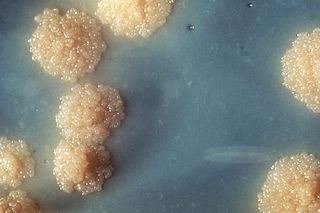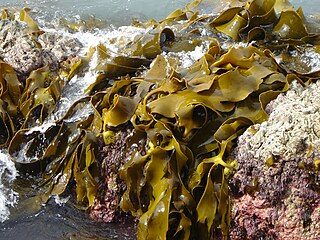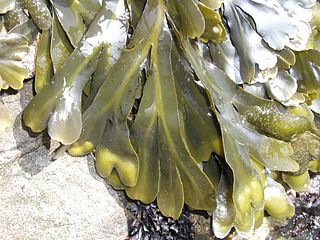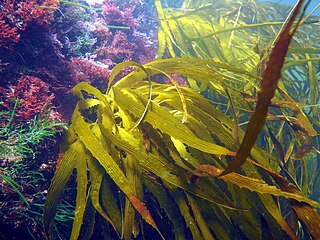
Fucus vesiculosus, known by the common names bladderwrack, black tang, rockweed, sea grapes, bladder fucus, sea oak, cut weed, dyers fucus, red fucus and rock wrack, is a seaweed found on the coasts of the North Sea, the western Baltic Sea and the Atlantic and Pacific Oceans. It was the original source of iodine, discovered in 1811, and was used extensively to treat goitre, a swelling of the thyroid gland related to iodine deficiency.

Mycobacterium tuberculosis, also known as Koch's bacillus, is a species of pathogenic bacteria in the family Mycobacteriaceae and the causative agent of tuberculosis. First discovered in 1882 by Robert Koch, M. tuberculosis has an unusual, waxy coating on its cell surface primarily due to the presence of mycolic acid. This coating makes the cells impervious to Gram staining, and as a result, M. tuberculosis can appear weakly Gram-positive. Acid-fast stains such as Ziehl–Neelsen, or fluorescent stains such as auramine are used instead to identify M. tuberculosis with a microscope. The physiology of M. tuberculosis is highly aerobic and requires high levels of oxygen. Primarily a pathogen of the mammalian respiratory system, it infects the lungs. The most frequently used diagnostic methods for tuberculosis are the tuberculin skin test, acid-fast stain, culture, and polymerase chain reaction.

Mycobacterium is a genus of over 190 species in the phylum Actinomycetota, assigned its own family, Mycobacteriaceae. This genus includes pathogens known to cause serious diseases in mammals, including tuberculosis and leprosy in humans. The Greek prefix myco- means 'fungus', alluding to this genus' mold-like colony surfaces. Since this genus has cell walls with a waxy lipid-rich outer layer containing high concentrations of mycolic acid, acid-fast staining is used to emphasize their resistance to acids, compared to other cell types.

Lessoniaceae are a family of kelp. Species of this family have a transition zone with the intercalary meristem subdivided so that there are a number of secondary stipes in addition to the primary stipe.

Alaria esculenta is an edible seaweed, also known as dabberlocks or badderlocks, or winged kelp, and occasionally as Atlantic Wakame. It is a traditional food along the coasts of the far north Atlantic Ocean. It may be eaten fresh or cooked in Greenland, Iceland, Scotland and Ireland. It is the only one of twelve species of Alaria to occur in both Ireland and in Great Britain.

Arame, sea oak is a species of kelp, of the brown algae, best known for its use in Japanese cuisine.

Lessonia is a genus of large kelp native to the southern Pacific Ocean. It is the only kelp to be restricted to the southern hemisphere and is primarily distributed along the coasts of South America, New Zealand, Tasmania, and the Antarctic islands. Lessonia is one of two principal genera in kelp forests.
Mycobacterium africanum is a species of Mycobacterium that is most commonly found in West African countries, where it is estimated to cause up to 40% of pulmonary tuberculosis. The symptoms of infection resemble those of M. tuberculosis.

Mycobacterium kansasii is a bacterium in the Mycobacterium genus. It is an environmental bacteria that causes opportunistic infections in humans, and is one of the leading mycobacterial causes of human disease after tuberculosis and leprosy.
Mycobacterium canettii, a novel pathogenic taxon of the Mycobacterium tuberculosis complex (MTBC), was first reported in 1969 by the French microbiologist Georges Canetti, for whom the organism has been named. It formed smooth and shiny colonies, which is highly exceptional for the MTBC. It was described in detail in 1997 on the isolation of a new strain from a 2-year-old Somali patient with lymphadenitis. It did not differ from Mycobacterium tuberculosis in the biochemical tests and in its 16S rRNA sequence. It had shorter generation time than clinical isolates of M. tuberculosis and presented a unique, characteristic phenolic glycolipid and lipo-oligosaccharide. In 1998, Pfyffer described abdominal lymphatic TB in a 56-year-old Swiss man with HIV infection who lived in Kenya. Tuberculosis caused by M. canettii appears to be an emerging disease in the Horn of Africa. A history of a stay to the region should induce the clinician to consider this organism promptly even if the clinical features of TB caused by M. canettii are not specific. The natural reservoir, host range, and mode of transmission of the organism are still unknown.

Isocitrate lyase, or ICL, is an enzyme in the glyoxylate cycle that catalyzes the cleavage of isocitrate to succinate and glyoxylate. Together with malate synthase, it bypasses the two decarboxylation steps of the tricarboxylic acid cycle and is used by bacteria, fungi, and plants.
The Mycobacterium tuberculosis complex is a genetically related group of Mycobacterium species that can cause tuberculosis in humans or other animals.

Phlorotannins are a type of tannins found in brown algae such as kelps and rockweeds or sargassacean species, and in a lower amount also in some red algae. Contrary to hydrolysable or condensed tannins, these compounds are oligomers of phloroglucinol (polyphloroglucinols). As they are called tannins, they have the ability to precipitate proteins. It has been noticed that some phlorotannins have the ability to oxidize and form covalent bonds with some proteins. In contrast, under similar experimental conditions three types of terrestrial tannins apparently did not form covalent complexes with proteins.

In biochemistry, naturally occurring phenols are natural products containing at least one phenol functional group. Phenolic compounds are produced by plants and microorganisms. Organisms sometimes synthesize phenolic compounds in response to ecological pressures such as pathogen and insect attack, UV radiation and wounding. As they are present in food consumed in human diets and in plants used in traditional medicine of several cultures, their role in human health and disease is a subject of research. Some phenols are germicidal and are used in formulating disinfectants.

Fucus gardneri is a species of seaweed, a brown alga living on the littoral shore of the Pacific coasts of North America. It has the common names of rockweed and bladderwrack.

Alaria marginata, the winged kelp, is a brown alga species in the genus Alaria. It can grow up to 13 feet. Fronds are long and narrow with raised midrib and wavy edges. Each frond has two rows of several smooth, oblong, 5 inch spore-bearing blades at the base in winter.

Saringosterol is an isolate of Lessonia nigrescens that has activity against Mycobacterium tuberculosis.
Lessonia trabeculata is a species of kelp, a brown alga in the genus Lessonia. It grows subtidally off the coasts of Peru and northern and central Chile, with the closely related Lessonia nigrescens tending to form a separate zone intertidally. Lessonia trabeculata kelp have gained a great economic importance for alginate production, and its harvest has greatly intensified along the Chilean coast during past two decades
Medialuna ancietae is a species of sea chub native to the Pacific coast of South America where it inhabits the giant kelp forests. It is known locally as acha, mero del sur or chino.

Lessonia corrugata is a species of kelp, a brown algae in the genus Lessonia, commonly known as strapweed, common crapweed, or Tasmanian kombu. It is a subtidal species endemic to Tasmania and southern Victoria, Australia, and is the least studied of the only three Laminarian kelps in the region. The species was first described by Arthur Henry Shakespeare Lucas in 1931, and is most closely related to the New Zealand species Lessonia variegata.
















